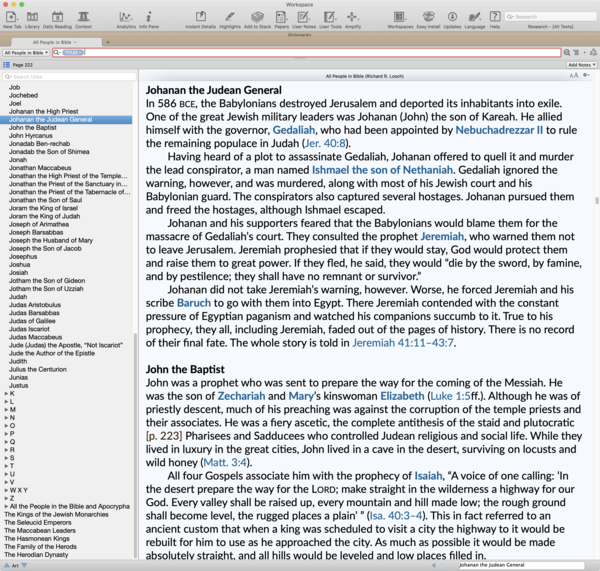 If you’re already thinking to yourself, “I don’t need another Bible dictionary; I’ve got plenty of Bible dictionaries,” please keep reading a bit longer.
If you’re already thinking to yourself, “I don’t need another Bible dictionary; I’ve got plenty of Bible dictionaries,” please keep reading a bit longer.
All the People in the Bible: An A-Z Guide to the Saints, Scoundrels, and Other Characters in Scripture by Richard Losch is not your typical, dry Bible dictionary. Losch writes the entries in narrative fashion with a style that is personal, witty, and occasionally (with appropriateness) a bit sarcastic.
When the title says, “All the People in the Bible,” it means just that. Everyone is covered here, although insignificant people who only appear in genealogies and have no bearing on the story of the Bible will only be included in a list without a separate entry. However, there are entries for insignificant characters—whether mentioned in the Bible or not—if they had greater impact in world history. Losch goes beyond just the biblical data to occasionally include information from pseudepigrapha and other ancient legends and histories.
Major biblical characters are covered in All the People in the Bible as you would expect in any Bible dictionary, but the major focus is “on the lesser characters in the Bible than on the great.” The bulk of the dictionary focuses on biblical characters, but there are also separate sections for “All the people in the Bible and Apocrypha,” kings of the Jewish monarchies, Seleucid emperors, Maccabean leaders, Hasmonean kings, and the Herodian family line and dynasty.
To give you a taste for the entries, here are a few excerpts. Note that none of these excerpts constitutes the entire longer entry for each subject.
Samson. Instead of spiritual strength, it seems that Samson was given great physical strength. He was something of an enigma. He was ostensibly a holy man, yet he had a vile temper, an insatiable thirst for vengeance, and a penchant for immoral women (rather like Rasputin). Apparently the only part of his vow that Samson observed was that no razor should ever touch his head, because there was liberal use of wine at many of his encounters with Delilah and the Philistines. He also violated Jewish Law in eating the honey from the lion’s carcass, because any contact with a dead body, including that of an animal (except one that was ceremonially killed), made a person ritually unclean (Judg. 14:8ff.)…The collection of Samson stories in the book of Judges is an example of ancient Hebrew story-telling at its best.
Delilah. That Samson continued to be with her despite her attempts to deceive him is evidence that his infatuation had completely overcome his wisdom and his caution. It even makes one question his intelligence. One can picture Delilah pouting in the corner whining, “How can you say, ‘I love you,’ when you won’t confide in me?” (Judg. 16:15).
Abraham. Probably the most common image that people hold of Abraham is that of a wandering mystic, the founder of a new religion. Nothing could be further from the truth. He was, indeed, the patriarch through whom God first revealed himself to what would become the Jewish people. However, he was in no way a gaunt ascetic roaming the hills of Canaan, but the ancient counterpart of a very wealthy Bedouin sheik ruling over hundreds of subjects and retainers. His name was Abram, and it was changed to Abraham when he made the final confirmation of his covenant with God.
Lazarus of Bethany. John reports that the word of this miracle shocked his enemies to the point that they were ready to kill Jesus (John 11:53), and it was unquestionably one of the most important events in Jesus’ ministry short of the passion itself. This immediately raises the question of why such an important event is not mentioned by any of the other three evangelists. Some believe that the story is a fiction, having grown out of the parable of Lazarus and Dives (in which Jesus said that they would not believe even if one returned from the dead). This, however, does not account for the presence of Mary and Martha in the story. It is also possible that the others had not heard of it, but this is unlikely. A reasonable explanation is that Matthew, Mark, and Luke chose not to tell the story during the lifetime of Lazarus, because his very existence was a threat to the enemies of Christianity, who would be happy to see him dead.
In the novel The Last Temptation of Christ, Nikos Kazantzakis presents an entirely different view of Lazarus. In his account Lazarus is restored to life but retains the ravages of four days’ decay in order to demonstrate the unimportance [p. 257] of life in this world compared to everlasting life with God. He is then murdered by fanatics. While this is out of the mainstream of Christian theology, it is certainly not inconsistent with it. It presents a fascinating image to contemplate.
Jonah. While the first part of the book deals with an unwilling prophet, the second deals with a petulant one. When Jonah preached his message of repentance to Nineveh, the king rent his clothes, proclaimed a fast, demanded that his people change their ways, and prayed that God would not destroy the city as Jonah had prophesied. God had compassion on them and spared the city.
Jonah was furious and stomped out of the city, saying that he wanted to die. He represents a typical weakness of the overzealous—he preached the compassion of God and then was angry when it was bestowed on a people who did not think exactly as he did.
Judas Iscariot. Judas Iscariot is undoubtedly one of the most despised men in history. His very name has become a synonym for treachery and betrayal, and in the Inferno Dante places him in the deepest pit in Hell.1 He is also a great enigma. Almost everything about him poses questions for which there are few or no answers. … We will never know for sure what motivated Judas to deliver up Jesus, and this may be just as well. The aura of mystery and the plethora of unanswered questions enable us to see ourselves in him. The weakness, misplaced zeal, and misunderstanding of the truth that we see in Judas we can also see in ourselves, underscoring the belief of Christians that only the death and resurrection of Jesus could save us from the same faults that are within all human beings.
Mary Magdalene. She is also the center of much controversy. In recent years, because of the novel The Da Vinci Code, a number of ancient and mostly forgotten traditions have resurged. These include the claim that she was Jesus’ wife and that she was chosen by Jesus to lead the apostles, only to be suppressed later by the male apostles and by the church. These stories have gained wide popular interest, but they are given little credence by most scholars.1
The most commonly believed story about Mary is that she was a reformed prostitute. There is absolutely no evidence for this claim, and the consensus among scholars is that it is patently untrue. The reason for this misconception is that Luke introduces her immediately following a story of a prostitute (Luke 7:36ff.), and readers have associated the two women. In the sixth century CE Pope Gregory I made this association in a sermon, and Mary has been identified as a prostitute ever since. Luke introduces her in the next chapter (8:2) as one of several women who had been cured of diseases and evil spirits. Prostitution (or any moral lapse) was not considered by the Jews to be the work of possession by evil spirits but the result [p. 278] of human sinfulness. Luke says that Mary was freed of seven demons, indicating some kind of mental or spiritual problem. She may have had a nervous breakdown, some serious neurosis, or deep depression, and apparently Jesus cured her. The statement that there were seven demons denotes that her condition was very serious and probably recurrent.
Luke also identifies her as a financial supporter of Jesus (8:3), indicating that she was one of his patrons.
All the People in the Bible: An A-Z Guide to the Saints, Scoundrels, and Other Characters in Scripture by Richard Losch is available with introductory discounted pricing for a limited time.
All the People in the Bible
Regular Price $25.90


